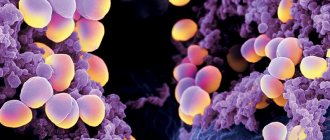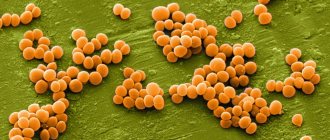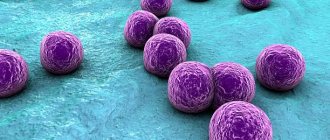Staphylococcus aureus (Staphylococcus aureus)
Staphylococcus aureus
(
Staphylococcus aureus
) is the most pathogenic species of staphylococci, the causative agent of purulent-inflammatory lesions in humans.
Staphylococcus aureus in healthy people
Staphylococcus aureus most often colonizes the nasal passages and axillary areas.
Chronic carriage is typical for personnel of medical institutions, patients with atopic dermatitis, and drug addicts. The main reservoir of Staphylococcus aureus in healthy people is the nasal cavity. However, Staphylococcus aureus can also live in the larynx, perineum, armpits, scalp and gastrointestinal tract. In the first 2 years of life, only 20% of children are carriers of Staphylococcus aureus in the nasal cavity. At 4–6 years old, 30–50% of children have Staphylococcus aureus in the nose. Staphylococcus aureus is found in the nasal cavity of 12–50% of non-hospital-associated adults.
After hospitalization, 20–30% of patients become carriers, mainly of hospital strains of Staphylococcus aureus. This is especially true for patients who have taken antibiotics, have diabetes or have infectious diseases and are on hemodialysis. Hospital strains of Staphylococcus aureus are responsible for many purulent diseases and wound infections in hospitals. The presence of Staphylococcus aureus in the nasal passages can cause wound infections.
Among medical personnel, carriage of Staphylococcus aureus in the nasal passages can reach 35%.
Staphylococcus aureus appears after the first menstruation in 5–15% of women. The number of carriers of Staphylococcus aureus increases during menstruation and reaches 30% of women.
Staphylococcus aureus
is a urease-producing bacterium.
Therefore, the presence of Staphylococcus aureus
in the patient’s stomach can cause false-positive results of urease tests for
Helicobacter pylori
, including the rapid urease test for biopsy (Starostin B.D.).
On the website GastroScan.ru in the “Literature” section there is a subsection “Microflora, microbiocenosis, dysbiosis (dysbacteriosis)”, containing articles addressing the problems of microbiocenosis and dysbiosis of the human gastrointestinal tract.
Methicillin-resistant Staphylococcus aureus
Some strains of Staphylococcus aureus have acquired resistance to a wide range of antibiotics, in particular to penicillins (methicillin, dicloxacillin, nafcillin, oxacillin, etc.) and cephalosporins. These strains, called methicillin-resistant
(or
methicillin-resistant
, or
MRSA
from
Methicillin-resistant Staphylococcus aureus
) Staphylococcus aureus, are becoming widespread. In the United States, the number of methicillin-resistant Staphylococcus aureus infections is increasing by 10% annually. Infection with methicillin-resistant Staphylococcus aureus is possible in any public place. The mortality rate from methicillin-resistant Staphylococcus aureus infections is about 30%. Every year, more than 20 thousand people die from infections caused by methicillin-resistant Staphylococcus aureus in the United States alone.
Analysis of stool and other biological material for Staphylococcus aureus
The amount of Staphylococcus aureus is determined by analyzing stool for dysbacteriosis.
In addition, testing for Staphylococcus aureus and methicillin-resistant Staphylococcus aureus in feces, discharge from the oropharynx, nose, paranasal sinuses and other biological material is performed if a staphylococcal infection or bacterial carriage is suspected, as well as during periodic examination of medical personnel in surgical departments of hospitals and maternity hospitals. Normally, Staphylococcus aureus should be absent from test results. Since Staphylococcus aureus is the only coagulase-positive pathogenic staphylococcus, determining the type of staphylococcus ( S. aureus
or not) in human biological material is produced using a coagulase test.
Antibiotics active against Staphylococcus aureus
Antibacterial agents (those described in this reference book) active against Staphylococcus aureus: clarithromycin, azithromycin, josamycin, amoxicillin, rifaximin, furazolidone, nifuroxazide, vancomycin, nifuratel, ciprofloxacin, norfloxacin, ofloxacin, clindamycin, tetracycline, lincomycin, clotri mazol.
Most methicillin-resistant Staphylococcus aureus are resistant to ciprofloxacin and roxithromycin. Methicillin-sensitive strains of Staphylococcus aureus are sensitive to levofloxacin, moxifloxacin, roxithromycin. Regarding Staphylococcus aureus
Saturated fatty acids are also active, especially those with 8 to 16 carbon atoms.
The antibiotic activity of saturated fatty acids depends significantly on the acidity of the environment. With an increase in pH from 6 to 7, the activity of, for example, lauric acid against Staphylococcus aureus
quickly decreases.
Staphylococcus aureus in the taxonomy of bacteria
The species Staphylococcus aureus belongs to the genus Staphylococcus (Staphylococcus)
, which is included in the family
Staphylococcaceae
, order
Bacillales
, class
Bacilli
,
phylum Firmicutes
, <group without rank>
Terrabacteria group
, kingdom Bacteria.
Staphylococcus aureus in ICD-10
Staphylococcus aureus
is mentioned in “Class I. Certain infectious and parasitic diseases (A00-B99)” of the International Classification of Diseases ICD-10, it is included in the blocks:
- “A30-A49 Other bacterial diseases” and has the heading code “A41.0 Septicemia caused by Staphylococcus aureus”.
- “B95-B98 Bacterial, viral and other infectious agents”, heading code “B95.6 Staphylococcus aureus
as a cause of diseases classified in other headings”. This code is intended to be used as an additional code when it is appropriate to identify infectious agents of diseases classified in other headings.
Back to section
Features of diagnostics
Taking a smear from the oral mucosa is not accompanied by pain; the patient just needs to throw his head back, opening his mouth wide.
To collect the material, the laboratory technician uses a cotton swab (sterile), which he uses to treat the mucous membrane of the throat, lightly pressing the tongue with a wooden spatula. The procedure is performed carefully so as not to provoke the urge to vomit. The study of the obtained material is carried out using the two most informative methods - microscopic and cultural, which solve different diagnostic problems.
Microscopic method
Technology using a microscope allows you to examine microscopically small objects (staphylococci) to determine the external as well as internal signs of the pathogen using the Gram method. The sample placed on glass is treated with one of the aniline dyes. After washing off the dye fixed with iodine, the gram-positive cocci present in the solution, single, paired, or their clusters, turn blue.
staphylococcus aureus
Staphylococcus of the Aureus variety found in the selected material is not always a threatening fact. If the norm of microbes in the smear is not exceeded, S. Aureus is considered a member of the conditionally friendly microbiota taken from the patient's throat.
Microscopy with Gram staining of the test sample is a preliminary diagnostic method. The technique is used only to confirm the presence or absence of chains of pathogens (spherical cocci) in the test preparation. The result is ready in 3-5 days.
Culture method
To accurately determine the degree of pathogenicity of Staphylococcus aureus, it is necessary to isolate a pure culture of bacteria. To do this, the selected material is placed in a nutrient medium that simultaneously performs a differential diagnostic function.
Pathogenic Aureus has a good ability to be cultivated on a variety of nutrient media. Mostly, solutions based on agar are used - meat peptone, salt, blood, the temperature of which is not higher than 37º C, but not lower than 30º C.
As the study progresses, it is important to consider the occurrence of possible deviations from the typical parameters of S. Aureus:
- loss of normal gram positivity under the influence of ultraviolet radiation, as well as lysozyme;
- the appearance of golden pigmentation does not always indicate the pathogenicity of the pathogen due to the widespread use of antibiotics.
If there are no symptoms of the disease, but Staphylococcus aureus is sown in a throat smear, this is not a reason to prescribe antibiotics. However, the combination of symptoms with test results already requires antibacterial therapy based on an antibiogram.
To obtain data on the sensitivity of detected bacteria to a specific type of antibiotic, the microbe is distributed over a solid nutrient medium and covered with material impregnated with different types of antibiotics. Those drugs that suppress the growth of the culture will be most effective in eradicating the infectious agent. The result can be obtained in 7 days.
How is the level of staphylococcus measured?
The interpretation of the results of a smear test for Staphylococcus aureus can be as follows: there is no growth of bacteria (reference values) or the growth of pathogens is detected (acute course or asymptomatic carriage). A negative result indicates a low likelihood of infection with Staphylococcus aureus. The resulting value is displayed in units of CFU/ml, which corresponds to the number of S. Aureus colony-forming units per milliliter of medium.
further reading
- Crompton, Marcus J.; Dunstan, R. Hugh; McDonald, Margaret M.; Gottfries, Johan; von Eiff, Christoph; Roberts, Timothy K.; Zhou, Dongsheng (8 April 2014). "Small changes in environmental parameters lead to changes in antibiotic resistance, cell morphology and membrane fatty acid composition in Staphylococcus lugdunensis." PLOS ONE
.
9
(4):e92296. Doi:10.1371/journal.pone.0092296. PMC 3979647. PMID 24714666. - Missineo, A.; Di Poto, A.; Geoghegan, J. A.; Rindi, S.; Heilbronner, S.; Gianotti, V.; Arciola, C. R.; Foster, T. J.; Speziale, P.; Pietrocola, G. (June 2014). "IsdC from Staphylococcus lugdunensis induces biofilm formation under low-iron growth conditions." Infection and immunity
.
82
(6):2448–2459. doi:10.1128/IAI.01542-14. PMC 4019187. PMID 24686057.
Acute postoperative endophthalmitis
Acute postoperative endophthalmitis caused by: C. lugdunensis
rarely reported in clinical studies. Five cases of acute postcataract surgical endophthalmitis were taken from a multicenter prospective study conducted in four university hospitals in France (2004 to 2005). These cases were characterized by severe ocular inflammation that occurred with a mean delay of 7.6 days after cataract surgery, severe vision loss (arm movement or less in three cases), and dense vitreous infiltration. Each of these patients was initially treated with a standard protocol using intravitreal (vancomycin and ceftazidime), systemic, and topical antibiotics. Given the severity of the endophthalmitis, although the bacteria were sensitive to intravitreal antibiotics, pars plana vitrectomy was required in four cases. The final vision prognosis was complicated by severe retinal detachment in three cases. Microbiological diagnosis was made using conventional cultures with specific biochemical tests and eubacterial PCR amplification followed by direct sequencing.
external reference
- Type strain of Staphylococcus lugdunensis
in Bac
Dive
- Bacterial Diversity Metadatabase
- Biological portal
| Taxon identifiers |
|




